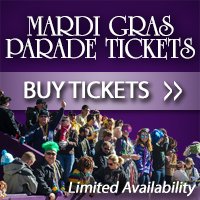- The Krewe of Zulu begin at S. Claiborne and Jackson Avenue.
- They parade down Jackson to St. Charles Avenue where they take a left turn.
- They follow St. Charles Avenue around Lee Circle and then continue back down St. Charles to Canal Street.
- At Canal Street, the Krewe takes a left turn.
- They follow Canal until Basin Street where they take a right turn.
- The continue on Basin Street to where it becomes Orleans Avenue.
- The parade follows Orleans Avenue until it concludes at Broad Street.

Early in 1909, a group of laborers in a club named “The Tramps” went to the Pythian Theater to see a musical comedy that included a skit entitled, "There Never Was and Never Will Be a King Like Me" about the Zulu Tribe. According to legend, after seeing the skit, they retired to their meeting place (a room in the rear of a restaurant/bar in the 1100 block of Perdido Street), and emerged as Zulus. The rest, as they say, is history. Years of extensive research by Zulu's staff of historians, however, seem to indicate that Zulu's beginning was much more complicated than that.
Conversations and interviews with older members indicate that, back in the day, the city was divided into wards, and each ward had its own group or “Club.” The Tramps were one such group. The group that founded Zulu was probably made up of both members from the Tramps and other ward-based groups and members of a Benevolent Aid Society. Benevolent Societies were the first forms of insurance in the Black community. For a small amount of dues, members received financial help when they got sick or there was a funeral to pay for.
While the men marched in Mardi Gras as early as 1901, their first appearance as Zulus came in 1909, with William Story as King. The group wore raggedy pants, and had a Jubilee-singing quartet in front of and behind King Story. His costume of "lard can" crown and "banana stalk" scepter has been well-documented. The Kings following William Story in the early days were similarly attired.
The year 1915 heralded the first use of floats, constructed on a spring wagon, using dry good boxes. The float was decorated with palmetto leaves and moss and carried four Dukes along with the King. That humble beginning gave rise to the lavish floats we see in the Zulu parade today.
Today Zulu is famous for their coconut throw – quite possibly the most coveted throw in all of Mardi Gras. Zulu’s honor guard is called the Soulful Warriors; and they have characters including Big Shot, Witch Doctor, Ambassador, Mayor, Province Prince, Governor and Mr. Big Stuff.
The most famous Krewe of Zulu king was Louis Armstrong who reigned in 1949.
- Year founded: 1909
- Membership: 1500 male riders
- Signature throw: hand decorated coconuts
Floats by Kern Studios »































































